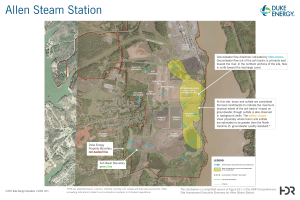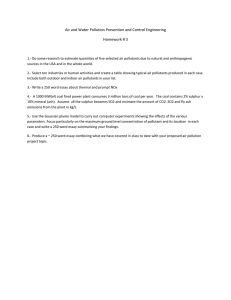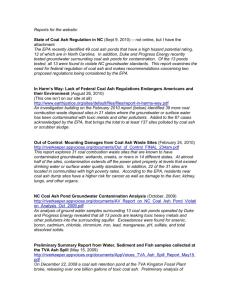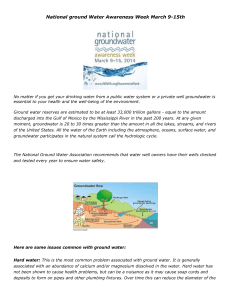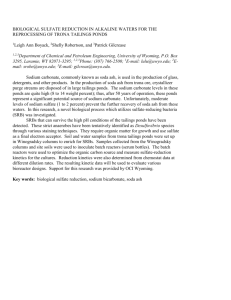Illinois and the Threat to Public Health from Coal Ash
advertisement
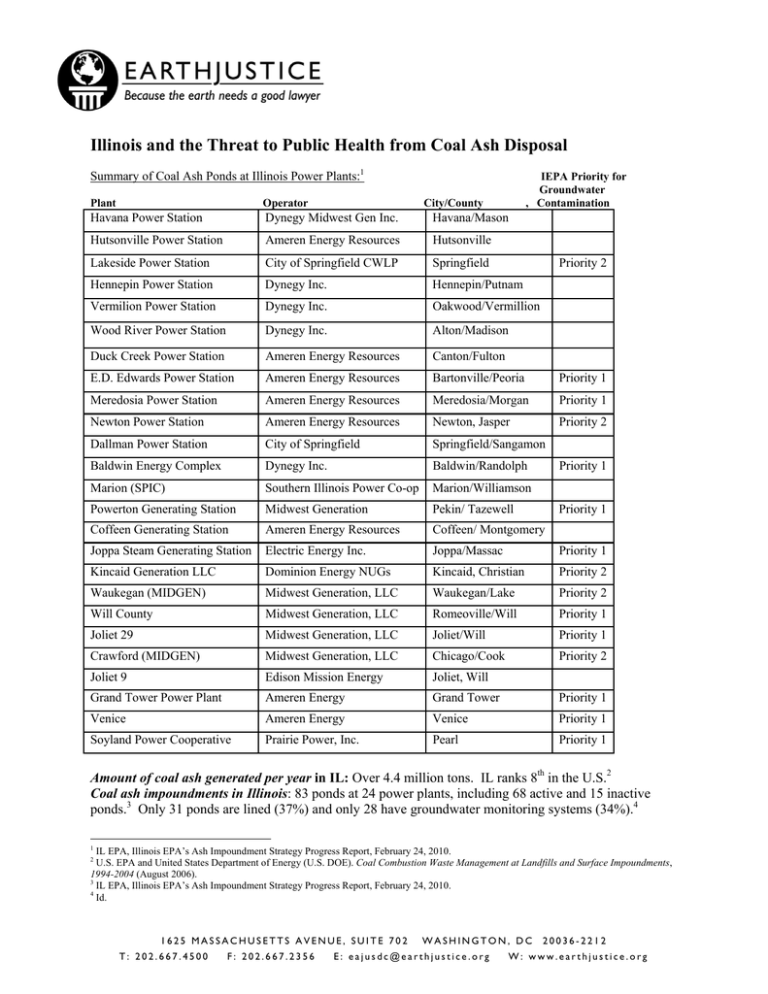
Illinois and the Threat to Public Health from Coal Ash Disposal Summary of Coal Ash Ponds at Illinois Power Plants:1 IEPA Priority for Groundwater , Contamination Plant Operator Havana Power Station Dynegy Midwest Gen Inc. City/County Havana/Mason Hutsonville Power Station Ameren Energy Resources Hutsonville Lakeside Power Station City of Springfield CWLP Springfield Hennepin Power Station Dynegy Inc. Hennepin/Putnam Vermilion Power Station Dynegy Inc. Oakwood/Vermillion Wood River Power Station Dynegy Inc. Alton/Madison Duck Creek Power Station Ameren Energy Resources Canton/Fulton E.D. Edwards Power Station Ameren Energy Resources Bartonville/Peoria Priority 1 Meredosia Power Station Ameren Energy Resources Meredosia/Morgan Priority 1 Newton Power Station Ameren Energy Resources Newton, Jasper Priority 2 Dallman Power Station City of Springfield Springfield/Sangamon Baldwin Energy Complex Dynegy Inc. Baldwin/Randolph Marion (SPIC) Southern Illinois Power Co-op Marion/Williamson Powerton Generating Station Midwest Generation Pekin/ Tazewell Coffeen Generating Station Ameren Energy Resources Coffeen/ Montgomery Joppa Steam Generating Station Electric Energy Inc. Joppa/Massac Priority 1 Kincaid Generation LLC Dominion Energy NUGs Kincaid, Christian Priority 2 Waukegan (MIDGEN) Midwest Generation, LLC Waukegan/Lake Priority 2 Will County Midwest Generation, LLC Romeoville/Will Priority 1 Joliet 29 Midwest Generation, LLC Joliet/Will Priority 1 Crawford (MIDGEN) Midwest Generation, LLC Chicago/Cook Priority 2 Joliet 9 Edison Mission Energy Joliet, Will Grand Tower Power Plant Ameren Energy Grand Tower Priority 1 Venice Ameren Energy Venice Priority 1 Soyland Power Cooperative Prairie Power, Inc. Pearl Priority 1 Priority 2 Priority 1 Priority 1 Amount of coal ash generated per year in IL: Over 4.4 million tons. IL ranks 8th in the U.S.2 Coal ash impoundments in Illinois: 83 ponds at 24 power plants, including 68 active and 15 inactive ponds.3 Only 31 ponds are lined (37%) and only 28 have groundwater monitoring systems (34%).4 1 IL EPA, Illinois EPA’s Ash Impoundment Strategy Progress Report, February 24, 2010. U.S. EPA and United States Department of Energy (U.S. DOE). Coal Combustion Waste Management at Landfills and Surface Impoundments, 1994-2004 (August 2006). 3 IL EPA, Illinois EPA’s Ash Impoundment Strategy Progress Report, February 24, 2010. 4 Id. 2 1625 MASSACHUSETTS AVENUE, SUITE 702 T: 202.667.4500 F: 202.667.2356 WASHINGTON, DC E: eajusdc@earthjustice.org 20036-2212 W: www.earthjustice.org Threat of Contamination to Drinking Water Aquifers: IEPA considers 10 of the 24 plants to be “priority 1 facilities” because of the high potential for contamination of the water table and/or the presence of drinking water wells near the plants. Coal Ash Pond Hazard Ratings: Two ponds rated “high hazard.”5 Historical releases from coal ash ponds: The Lakeside Plant pond has had seepage problems at its northern embankment, and the fly ash pond at the Meredosia Power Station had a spill in 2006.6 Damage Cases: According to the U.S. EPA, coal ash has contaminated water at the following sites:7 Powerton Plant: exceedances of cadmium, lead, nitrite, iron, manganese, and sulfate. Duck Creek Station: exceedances of sulfate, total dissolved solids (TDS), chloride, manganese, and iron in groundwater. Hennepin Power Station: exceedances of sulfate and TDS in groundwater. Havana Power Plant: exceedances of manganese in groundwater. Vermillion Power Station: exceedances of sulfate and TSD in groundwater. Hutsonville Power Station: exceedances of sulfate and TDS in groundwater. Wood River Power Station: exceedances of sulfate, TDS, chloride, manganese, and iron. Coffeen/White & Brewer Fly Ash Landfill: exceedances of sulfate, TDS and manganese in groundwater. According to IL EPA, groundwater data received in 2010 revealed chemicals above drinking water standards as a result of coal ash disposal at the following eight plants: Lakeside Power Station: Arsenic (9 times drinking water standard), sulfate, iron, manganese; Joppa Power Station (Priority 1): lead, sulfate, iron, manganese; Prairie Power Pearl Station (Priority 1): arsenic, selenium, sulfate, manganese, iron, chloride; Ameren-Meredosia (Priority 1): arsenic (nearly 15 times drinking water standard), sulfate, manganese; Powerton Station (Priority 1): arsenic, lead, manganese, iron; Waukegan (MIDGEN): arsenic, antimony, sulfate, manganese; Venice Plant (Priority 1): arsenic (over 15 times drinking water standard), manganese; and Joliet 29 (Priority 1): antimony, sulfate, manganese, chloride. Additional contaminated sites documented by EIP, Earthjustice and Sierra Club include:8 Marion Plant, Southern Illinois Power Cooperative, Marion, IL: Cadmium and iron- contaminated groundwater, and discharges containing high aluminum, boron and manganese to nearby creek. Joliet 9 Generating Station, Joliet, IL: Boron-contaminated water threatens private wells. Rocky Acres Coal Combustion By-Product Disposal Site, Oakwood, IL: “Beneficial reuse” site contaminated groundwater with arsenic, barium, lead, iron, manganese, chromium, nickel and iron. Deficiencies of Illinois Coal Ash Regulations: IL regulations fail to require many of the essential safeguards necessary to protect citizens from contamination by coal ash. IL regulations (1) fail to require groundwater monitoring and composite liners at all new and existing ponds and landfills; (2) fail to prohibit ash ponds from being constructed in the water table; (3) fail to require financial assistance for ponds; and (4) fail to require coal ash dams be regularly inspected by state regulators. For more information: contact Lisa Evans, Earthjustice, 781-631-4119, levans@earthjustice.org. 5 Id. U.S. EPA. Database of coal combustion waste surface impoundments (2009). 7 U.S. EPA. Coal Combustion Waste Damage Case Assessments (July 9, 2007). 8 EIP, Earthjustice and Sierra Club Reports, In Harm’s Way and Out of Control, available at www.earthjustice.org/coalash. 6
